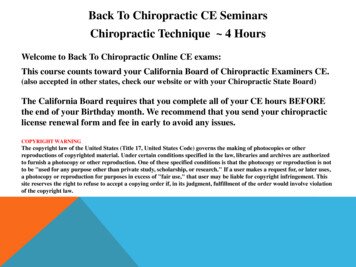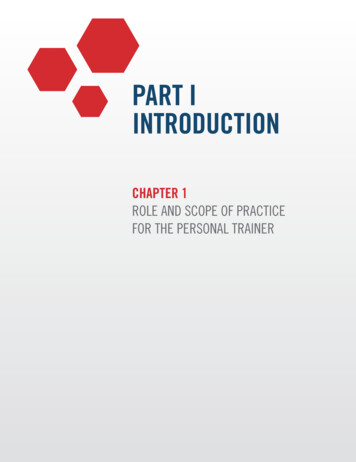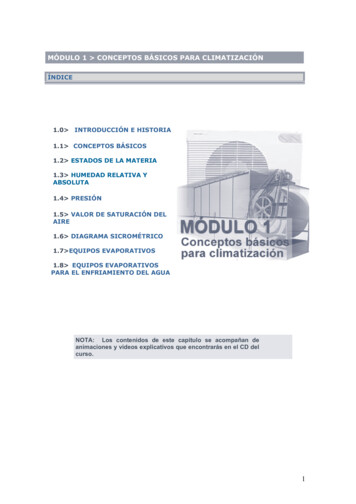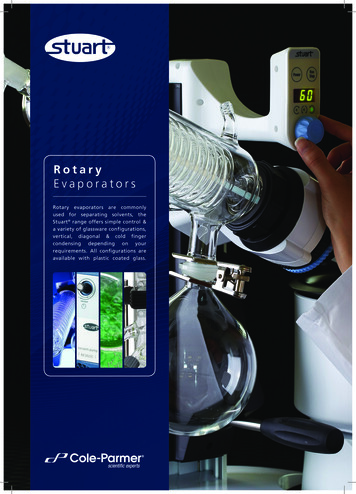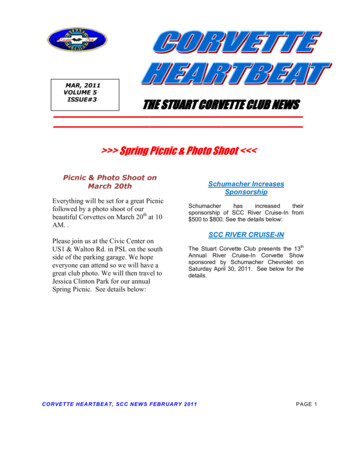
Transcription
Life is a succession ofles son s w h ic h m u st b eliv ed t o b e u n der st ood .Helen KellerBefore You Read This Book!Perform the following test with a family member or friend.a) Start with the subject standing up straight, right arm relaxed atthe side, left arm held up and parallel to the ground with theelbow straight. (The Kinesiological Test page 2)b) The observer facing the subject place your left hand on thesubject’s right shoulder for support. Place your right hand onyour subject’s left arm just above the wrist.c) Instruct the subject that you will apply pressure to his arm andthat he should try to stop you but it is not a competition to seewho is the strongest.d) Now apply steady, firm pressure. Use just enough pressure tosee a bounce or springing like reaction. Not so hard and longthat you overpower the subject. Can the subject’s arm keep orlock the shoulder in position against your observing pressure?e) The arm muscle should remain strong.f) Repeat the test as the subject does one of the following things,do all of these steps. In between each test of food, rinse yourmouth with some water before you go to the next test.I.Put a bite of bread in his mouthII.Put some sugar in his mouthIII.Put some milk in his mouthIV.Look at a flourescent light bulbV.Look at a picture of Adolph HitlerVI.Listen to several examples of current music hits .VII.Think of a stressful situation
2The Kinesiology Test – Beginning Position
Do It Yourself Stress Makeover3The results, more appropriately the observation of what happens will bedramatic. The majority of the time you will observe that your subject willnot be able to resist your pressure. The arm will go down fairly easily.You will also notice a look of shock or confusion on your subject’s face.What just happened? You used the same amount of pressure yet yoursubject went instantly and dramatically weak. Quite simply this is like alight switch, it is on or it is off. The subject’s arm is strong or it is not.When you insult the body with something nutritionally bad your bodyknows it. The problem is that most of us don’t feel anything instantlydifferent when we eat high sugar content food. The same is true if youare thinking about stressful or harmful situations. Your brain andnervous system knows and remembers everything that ever happenedto you, fortunately this is mostly at the subconscious level. We can,using this applied kinesiology procedure, observe what is creating yourproblems and causing you harm. We can also use this same protocolto determine what can help you right now!Copyright 2014, Dr. Evan Mladenoff B.Sc., D.C.,D.I.B.A.K., F.A.S.A.All Rights Reserved
4Table of ContentsLOSING THE BATTLE WITH STRESS?Can Stress Make You Sick?Holmes-Rahe Social Readjustment ScaleStress and SicknessThe Anatomy of StressAlarm ReactionResistance StageExhaustion StageThe Brain – Adrenal AxisThe Biological Clock — Circadian RhythmsSleep and Wake StagesBody TemperatureCardiovascular SystemMedicationCortisol Production192021242628323435373839394040STRESS SABOTAGES YOUR LIFE!DIY Temper TestDIY Job Stress/Hassle IndexHow Stress Harms Your BodyNervous System4546474849
Do It Yourself Stress MakeoverBrain Memory EmotionDementiaPanic AttacksDepressionSleep Deprived and InsomniaMusculoSkeletal SystemRespiratory SystemHypertension, Heart Disease and CortisolWeight Gain and Obesity Reflects StressImmune SystemEmotional stress takes its toll!AllergiesThyroidGlucose MetabolismHormone (Endocrine) SystemLow TestosteroneThe Consequences of Low TestosteroneDigestive SystemReproductive System . . . . Menstrual DisordersBone Loss – Osteopenia/OsteoporosisDermatologyChronic FatigueThe Taste of ChocolateDIY Stress Prone Personality SurveyThe DIY Stress Resistant Personality SurveySTRESS CAN EAT YOU ALIVEThe Power of ProteinSo What Is A Protein?Get Your Mojo BackThe Stress Free DietWhat to Expect When You Improve Your 47576818284869090
6DRIVING YOURSELF TO ILLNESS AND DISEASE96Setting Your Sights On New Health and Vitality97Back to the Basics99Human Biology 10199What is Protein?99What is a Fat?99What is a Carbohydrate?100What is a Hormone?100What is the Major Dietary Source of Hormone Imbalance? 100What is Insulin?101What is the Definition of Metabolism?101What is Anabolism?101What is Catabolism?102Understanding What To Do About Stress is Child’s Play103Eat Right — Live Longer112The Truth About Sugar113The Truth About Animal Fats115Using iStressedOut 118The STRESS ICEBERGThe Stress IcebergThe DIY Stress ExamsThe DIY 10 Second Stress TestApplied Kinesiology and Muscle TestingBlood Pressure Series - Ragland’s SignMid Range Stress AssessmentAdvanced Diagnostic TechnologyDiseases Associated With Loweed HRVLong Range Stress IndicatorsThe ASI Saliva Test122123131132136139143145146149150
7Do It Yourself Stress Makeover30 DAYS TO A STRESS FREE LIFE158The Essential Non-EssentialShort Range Treatment StrategiesPS Increases Metabolism Throughout Entire BrainBrainAging Reverses With PSHow Does PS Make Your Brain Younger?Memory and CognitionSports NutritionImproved Cycling PerformanceAttention Deficit Hyperactivity DisorderEndocrine and Psychological StressDietary Source of PSRelief From Stress In 30 Days or Less!iStressedOut (PS) Will Help Specific FFENSIVE GAME PLANSLEEP – The Most Beautiful Experience In Life.Prepare To Go To Bed and SleepPhase 1Phase 2Acupressure Points For SleepThe Power of MeditationMeditation 101ReBoot Your ComputerPut The DVD On PauseQiGong Wu Dang Zhan Zhuang QuanAcupressure Adrenal Treatments179179180180185187187192193195197201THE DO IT YOURSELF 30 DAY STRESS CAMP204The Stress-Free Diet Guidelines208The Stress-Free Relaxation Guidelines208End Notes293
8
Do It Yourself Stress Makeover19Worry and stress affects thecirculation, the heart, theglands, the whole nervoussystem, and prof oundly aff ect sheart action.LOSING THE BATTLE WITH STRESS?Just where does stress come from? Now more important, this book hasbecome an essential tool on how you can help yourself deal with thehorrific stress overload caused by events in our lives.As adults, we experience many different reactions to stress.Do you feel your pulse start to race?Do you get anxious and panicky?Does your chest feel constricted and heavy?Do you have to go to the bathroom all of a sudden?Are you palms sweaty?Is your brain agitated, foggy with trouble staying focused?Or, do you feel sharp and ready to go?Are you tired all of the time?Are you having trouble falling asleep?Following is a list of stressors. Does any of this sound like you?AllergiesAngerBody Financial InsecurityIllnessIndecisionJealousyMeaningless WorkMigraine or HeadachesNauseaPMSPremature AgingRelationship ProblemsShift WorkSleeping DisordersThis brief list may overstate the obvious and have you muttering “Whatwas I thinking?” These are all factors that we experience every day.
10We only pay attention to them when they are staring us in the face andwe must make an immediate decision. When we are pressed, forcedand stressed to make decisions – it is easy to avoid deciding, stick ourhead in the ground, pretend it does not exist and that is when wetypically make stupid decisions. If just looking at this list starts yourpulse racing, restricts your chest, brings up old memories a nd thesense that bad stuff is about to happen, then you are not alone.Believe it or not, even babies can experience physical stress as earlyas three to five days. What a shock to male infants to receive sacrificialcircumcision because . . . . ? Can you even imagine how high thestress hormone cortisol climbs? Circumcision produced a three to fourtime increase in blood cortisol 30 minutes after the surgery.1Throughout this book, I show you the way to check your current levelof wellness and which direction are you going. Is your first line ofdefense – the stress system, your marines on the beach so to speak,fighting the good fight, being vigilant and protecting their territory? Orare they slipping on the job and falling asleep at their post? You arethe closest person to observe this internal dialogue.Can you ask yourself and your body the correct questions to find theweak links and take simple measures that will impact your health,wellness, and begin a new, healthy stress-free life?Yes you can! At the very beginning of this book you experienced apowerful tool to perform a test and observe the result. This is oneprecise method how you can do this. These are just tools to help youget a handle on what affects you and the impact this has on everyaspect of your life. It is not an all inclusive diagnostic solution. Mostpeople will ignore the journey you are beginning and dismiss it as toosimple to possibly be good to do any help. These same people waituntil there is a life threatening crisis that is real to them that pushesthem into panic mode. At this point fear is the guide to what decisionswill be made.There are a number of tools that will help you determine if you are a
Do It Yourself Stress Makeover11prime candidate to get sick from stress. After you complete thesequestionnaires, I’ll explain the why and the how of stress-relatedillnesses, and then what can be done about them. Remember, theseare just tools — not an all-inclusive diagnostic evaluation.Physicians Thomas Holmes and Richard Rahe developed the followingquestionnaire. They designed it to reflect the disruptive effects of 43changes in a person’s life. Although each of us responds differently tothese events, the basic response of our bodies is the same. Despite themany advances of modern life, we’ve retained our primitive responsesto stress— the good AND the bad.The questionnaire is listed below. This exercise will give you an idea ofwhere your stress level currently registers. After completing theexercise, complete the other questionnaires on pages 75 and 76 andthe do the simple self-examination procedures. They will indicate thecurrent status of your stress-coping capabilities and if you’re stressedout to the point of being headed toward crash and burn.Directions: Circle each that have affected you and place the monthand year the event happened in the right-hand column. Then total yourscore at the bottom.DATE12345678910111213Death of a spouseDivorceMarital separationJail termDeath of close family memberPersonal injury or illnessMarriageFired at workMarital reconciliationRetirementChange in health of family memberPregnancySex difficulties100736563635350474545444039
383940414243Gain of a new family memberBusiness readjustmentChange in financial stateDeath of a close friendChange to different line of workChange in # of arguments with spouseMortgage over 10,000Foreclosure of mortgage or loanChanges in responsibilities at wokSon or daughter leaving homeTrouble with in-lawsOutstanding personal achievementWife (spouse) begins or stops workBegin or end schoolChange in living conditionsRevision of personal habitsTrouble with bossChange in work hours or conditionsChange in residenceChange in schoolsChange in recreationChange in church activitiesChange in school activitiesMortgage or loan less than 10,000Change in sleep habitsChange in number of family get-togethersChange in eating habitsVacationChristmasMinor violation of the 7161515131211TOTAL SCOREScoring Key: According to Drs. Holmes and Rahe, a score exceeding300 in one year indicated an 80 percent probability of developing a
Do It Yourself Stress Makeoverserious illness.Now, carefully review your answers and the year when the event(s)occurred. Did most happen within a 12-month period to give you a totalscore of more than 300 points?When completing the Holmes-Rahe questionnaire, consider thesethings: Both positive and negative events are listed. Your nervoussystem and your primitive response mechanisms can’t tellthe difference between too much bad stress and/or toomuch good stress. Some questions are vague, such as a change in financialstate. Whether an increase or a decrease, the effect is thesame on the body. Today mortgages over 100,000 are much more commonthan mortgages in the past that were over 10,000. How about a mortgage over 200,000 or even 500,000?Imagine the stress there? The high cost of housing, the banking fraud andgovernment corruption makes the American dream ofowning your own home out of the question for a lot ofpeople. Corporations are downsizing, and, as a result, morepeople are becoming self- employed today. While thismeans less corporate stress and answering to a boss, itdoesn’t alleviate all stress. There are distinct advantagesto having direct control over your direction, your hours andyour earnings. There are added pressures of running your own business:being your own boss and completely responsible for thebottom line. The stresses are different, but your bodyreacts the same. A recent study2 showed that when a terminally-ill patientexperienced financial stress, it caused depression in thecaregivers and suicidal thoughts in the patientsthemselves. The reality? The cost of dying can be veryhigh, approaching hundreds of thousands of dollars.13
14Everyone is constantly on the go, you probably know when you’refeeling stressed. But have you ever wondered where stress comesfrom? It’s the result of many complex reactions going on inside yourbody. These exercises will help you identify what causes stress in yourlife and some of the things you must do to alleviate it.Hans Selye, M.D., the father of stress management, was initially doingresearch on reproductive hormones. As is the case with most greatdiscoveries, he found something he wasn’t looking for. He discoveredand successfully reproduced a series of predictable body responsesthat always occurred before there was any diagnosable, recognizabledisease.Selye observed that patients who did not exhibit the characteristics ofa specific disease, all exhibited nonspecific features of a diseaseprocess. These features included fever, enlargement of the spleen orliver, inflamed tonsils, skin rash, aches and pains in the joints, stiffnessand many more seemingly vague symptoms. These vague symptomsare probably something that you have every day and ignore it becauseit doesn’t get worse, it doesn’t get better, it’s not cancer, my doctorthinks it’s in my head, I’m not going to die from it . . . . . you just blow itoff and ignore it!You just feel and know that there is something ‘off’ in your body. Selyecalled this the “ syndrome of just being sick.” This seemed to be thesyndrome that was present in all diseases.Later Selye did research by placing animals in various types of stresssituations: Living in overcrowded social conditionsComplete body immobilizationExposure to temperature extremesLiving in their own excrementAdverse dietary conditionsBeing chased around the lab by Selye and his studentsBeing dropped from the laboratory examination table.Does any of this sound like you? We have all experienced some of
Do It Yourself Stress Makeover15these conditions. We all at times think we have been in that exactsituation. Our mind will play tricks on us. If we think we have been in aspecific situation, our body reacts exactly like it is in that situation. Aperfect example of this is when America sent astronauts to the moon.Nobody had ever been there before. What were they supposed to do?They practiced a specific procedure to land on the moon. Theypracticed walking and working on the moon. They practiced blastingtheir spaceship off of the moon. They practiced coming home from themoon. They repeated this so many times that when the events actuallyhappened, they had fooled their minds and bodies thousands of timesbefore by pretending they had gone to the moon.We do the same thing. When we make a minor mistake at work, weimagine that our boss is mad at us. We then play a videotape ofsomething that has never happened. We imagine that our boss is madat us, hates us, thinks we are a worthless employee . . . . it is very easyfor something small to become huge in a very short amount of time.We cannot tell the difference between what is real and imagined. If wehave been in a specific situation, our mind and body react in a veryspecific way. If we think or imagine we have been in these situations,then our body reacts exactly like it has.Each time Selye found the following three things would happen:1. Enlargement of the adrenal cortex. An increase in size of thisessential life sustaining, life giving adrenal gland. It is over workingfull time. This is our 1st line of defense. The marines on the beachare on red alert and go to hand to hand combat.2. Atrophy of thymus, spleen, lymph nodes and all other lymphaticstructures. Our 2 nd line of defense, an internal mechanism is beingdrained to provide raw materials for the marines on the beach, theadrenal glands.3. Deep-bleeding ulcers in stomach and duodenum. Our first line ofprotection has been compromised. The second level of defensehas been drained to help keep the first level of defense going as
16long as possible. And now the flood gates have been opened andthe body is vulnerable to damage. The digestive system will nowbe sacrificed in the last stand to protect the body from moredamage.What does this mean to us? Under any condition—external orinternal—our body’s first response to stress is from the adrenal glands.Let’s take a closer look at what these little glands are and how theywork.The adrenal glands are two small glands about the size of a silverdollar. One is located on top of each kidney. This small body part withits unique development gives us clues as to the magnitude of itsimportance and the significance of stress.As we develop in our mother’s womb, the adrenal glands begin formingat about seven weeks. By about the seventh month the adrenal glandsare actually larger than the kidneys.There are three separate arteries that supply blood to each gland. Theyalso have a very extensive nerve supply. From the spine there is adirect non-stop nerve connection to the glands, and from the brain thereis also a direct connection to the glands. These two special featuresallow the gland to respond to minute changes in neurological function.Curious, why does such a small gland have 3 different arteriessupplying it, a nerve connection directly to the brain and a nerveconnection from the spine?The obvious answer is that it is a big deal and must respond quickly tovarious incoming stresses. It is our first line of defense – our marineson the beach.The beginning blueprint seen in Figure 1 shows the 3 paths of how wetell the marines on the beach that the incoming stress is ‘a friend or afoe’. There are 3 options.
Do It Yourself Stress Makeover171. Direct nerve impulse from the brain – very fastFigure 12. Indirect communication from brain to spine to adrenal glands. Themultiple nerve connections are a fraction slower and alert otherparts of the physical body to get ready for action.3. Blood stream connection from the brain to the adrenals. This isperhaps the most complex because there are many differenthormone pathways that are activated that will go to the adrenalsand many other places as well. Any hormone in the blood streamgoes to every part of the body that gets a blood supply.Selye continued to study the effects of various stressors on the body,
18he found that the body goes through three stages of reacting to stress,our ability to adapt and cope with the stress.The Alarm Reaction StageThe Resistance Stage TheExhaustion StageEach stage gives us valuable clues about our bodies and theirdecreased ability to adapt to stress.The first response is the alarm reaction. This “fight or flight” stage is aprimitive response retained from our caveman days. We either run andhunt for our lunch OR we run so that we don’t get eaten for lunch by asabre tooth tiger. We develop problems in our life because ofperceived lions and tigers attacking us! For example, the boss, the IRS,the mortgage company, your bank loan is due . . . . .Stress triggers a response in the brain that causes a chain reactionthrough our nervous system, this is our caveman survivor instinct. It isexactly like your knee jerking when it is tested with a reflex hammer.You have no control over it, your leg just kicks. This reaction goesdirectly to the adrenals where they produce specific hormones that areinstantly released into your blood stream. (Figure 2)When it’s life or death, certain bodily functions are not needed, soyour body can decrease or even shut them down, which is not badwhen you are being chased by a tiger, but not good when it occursday-in and day-out at work. Here are some of the systems thatdecrease or shut down due to stress: Digestive systemReproductive systemSkin vesselsSpleen functionElimination systems of colon and kidney/bladder
Do It Yourself Stress Makeover19Figure 2At the same time, stress increases those systems that empower yourmuscle and cardiovascular systems to work harder and longer byincreasing: Heart rate Blood supply to muscles Respiration SweatingThe Alarm Reaction provides superhuman strength in the mostdemanding situations, like the story of a 110-pound mother, without anythought, generates enough strength to lift a 2,000 pound-car and saveher child.If stress continues, the body will eventually run out of raw materials,causing the second stage, the Resistance Stage. The Alarm Reactionprovides an immediate, tactical response when stress first occurs, but
20it is not meant to serve as a long-term body response.Think of the stay at home mom, raising 3 kids, rushing them to practice,lessons, rehearsals and games from the instant they get out of schooluntil late at night. Then, she has to make dinner, help with thehomework, and get everybody ready for bed. Does any of this soundfamiliar? A never ending cycle of the will to provide, survive and thrive.And,The businessmen or women who are pushing to climb the ladder ofsuccess. Meetings all day, preparing presentations and bids.Negotiating sales and contracts. Sometimes they get a little w in tosustain their will to continue. Then you go to the next meeting,sometimes you land a big contract, most of the time you are met withdisinterest, rejection and failure. You go home look in the mirror andask yourself ‘and the reason I am doing this is?”For both of these people, perhaps this is even the dynamics of onefamily, they must persevere. Willingly or unwillingly they get up the nextmorning and start all over again. This same day can be repeated dayafter day, week after week, month after month, year after year . . . youget the idea of the same day being repeated 1000 times.How can you go on? How do you stop the vicious cycle? How do youcope and manage so that you do not become an instant cardiac deathstatistic?I have developed a self-preservation rule that has been used onthousands of patients that I call the “Midnight Rule.” Simply stated enjoy a victory, an accomplishment, completion of a milestone eventuntil midnight, and then the next morning focus on the next task orevent. If there has been a negative event, you lost a sales contract, youfailed a test – then you are allowed to moan, groan, cry and stay angryuntil midnight. Then you must put the negative event or outcome out ofyour mind and start preparation for the next day and week. Positiveoutcome or negative outcome your reaction should be the same.Celebrate or cry until midnight. Then regroup, prepare and continueagain. A pure example of this is precisely what a farmer does. The
Do It Yourself Stress Makeover21basic business plan is: plow, plant, water, harvest, repeat! Whateverhappened today good or bad tomorrow we: plow, plant, water, harvest,repeat!The easiest thing to do and, at the same time the most difficult – is toignore what has just happened, be detached from the outcome andfollow your dreams.There are 2 parts to manage in order to prevent the slow downwardspiral that stress can force on to us. This day to day, hand to handcombat that you endure – is it part of your dreams? If it is not part ofyour dreams, you are escorting yourself to your own demise. If it is yourdream to forge ahead then you must be detached from the outcome.“If one advances confidently in the direction of his dreams andendeavors to live the life which he has imagined, he will meet withsuccess unexpected in common hours.”I place this quote from Henry David Thoreau in several prominentplaces to act as a simple precise reminder from me to myself of what Imust do.If the stress continues, the body cannot continue the fighting actions ofthe alarm reaction indefinitely. It will run out of fuel and nutrients, thiswill force us into the second stage. (Figure 3) Now we must Resist thestress, and in order to do so we need to go shopping and get morefood and resources to continue the fight. Your body steals from 1 partand uses it someplace else that is running out of raw materials andhas urgent needs.For example if a women is pregnant, then all of the female hormonesare needed to nurture and develop the baby inside the womb. If she isnot pregnant and has a normal menstrual cycle, then all of the femalehormones appear to be extra and an excess amount because there isno baby inside her stomach. These apparent extra hormones can bestolen, changed and used for just about any reason because there is nobaby! The stealing and conversion of these seemingly extra hormonesgives you fuel to keep the fight against stress going.
22You are making massive withdrawals from your nutritional bankaccount without any possibility of replenishing or repaying yournutritional savings account. This impulsive, necessary spending spreeis now impacting your wellbeing by creating the ideal storm for seriousproblems to develop quickly. There are four specific responses thatoccur at this stage. (figure 3)
Do It Yourself Stress Makeover23Figure 31. The breakdown of carbohydrates and their conversion into useableglucose energy sources. If you cannot do this or you run out ofcarbohydrates then . . . .2. Fats get broken down and converted for energy use. If you are notgetting sufficient intake of the right fats and good fats then . . .3. Protein gets broken down from muscles, organs and glands, andconverted for energy use then . . .4. The response by the adrenal glands. (We will come back to this injust a moment.)
24When everyday life stress continues—along with excessive stimulationlike too much coffee, too much alcohol, disrupted sleep, insomnia, andnutrient depletion of sodium, calcium and magnesium, – the adrenalglands just poop out. Cortisol is one of the major hormones producedby the adrenal glands. If you make too much for too long you get oldfaster and you get diabetes faster and you die faster. The direct impactis that you destroy your body from the inside out.If you cannot make enough cortisol – you die. This is a disease thatrequires intervention. These people must receive a drug version ofcortisol to just survive the day and avoid death. History has revealedthree prominent people who had this disease, Addison’s disease, thatrequired these life sustaining drugs. The fascinating thing about this ishow their minds were affected in observing the world around them andthen, more importantly the decisions they made as a result of thedistorted view of the world they had. I will be discussing the adverseeffects of cortisol shortly. The 3 people I am referring to are PresidentAbraham Lincoln, Adolf Hitler and President John F. Kennedy. Acurious exercise would be to imagine how these prominent figures ofthe world would make decisions under huge amounts of stress if therestress system was working optimally, if they could adapt and thinkclearly?When your body is functioning properly and efficiently, there areminerals inside our cells to help absorb water. Simply, no mineralsinside the cells mean no water absorption. If you are not absorbingwater then you are dehydrated. We have a major problem here! Yourbrain will send you a signal that you are thirsty. The problem here isthat by the time you become thirsty it is too late. The impact ofinsufficient water can create major problems for you.The Mayo Clinic describes symptoms for mild to moderate dehydrationwill likely cause 3: Dry, sticky mouthSleepiness or tiredness — children are likely to be lessactive than usual
Do It Yourself Stress Makeover 25ThirstDecreased urine output — no wet diapers for three hours forinfants and eight hours or more without urination for olderchildren and teensFew or no tears when cryingDry skinHeadacheConstipationDizziness or lightheadednessUnfortunately, thirst isn't always a reliable gauge of the body's need forwater, especially in children and older adults. A better indicator is thecolor of your urine: Clear or light-colored urine means you're wellhydrated, whereas a dark yellow or amber color usually signalsdehydration.Stress disturbs the cellular water balance because of the mineralimbalance that is produced. The end result of this series of chemicalevents is decreased nutrient delivery to the cells. The adrenals willcause potassium levels to decrease, one of the most serious aspectsof intestinal diseases, and almost always present in stressed patients.Incoming stress affects us starting directly in the brain by a precise stepby step chain of events that occur along the Brain – Adrenal Axis (thischain of events is known as the Hypothalamic-Pituitary-Adrenal-AxisHPAA).Stressful events, activities, feelings and emotions can all trigger thebrain to release specific hormones directly into the blood system.These hormones travel through a specific chain of command to theadrenal glands. Four different kinds of hormones can be released;cor
Before You Read This Book! Perform the following test with a family member or friend. a) Start with the subject standing

